Tattoo Scarring: Is It Normal and How to Fix (Everything You Need to Know)
[ad_1]
Tattoo and scars – it’s an interesting topic. When you first get your tattoo, the area may be a little red, swollen, and even raised where strong black lines cut across your skin. But will the raised texture last? And what should you do if scars emerge after the tattoo has healed?
This article covers tattoo scars in general, from what they are and what causes them, to how to fix the problem. There are some quick FAQs at the end too if you’re in a rush.
Be warned, some of the photos in this article show infected tattoos. It’s graphic and not a pretty picture!
Tattoo Scarring: What Is It?

Tattoo scarring refers to any scar that occurs due to the tattoo process – depending on the type of scar, it may become visible very quickly or take years to develop.
This is different to tattooing over scars and scars caused by laser tattoo removal. If you’re interested in either of these topics, scroll down our guide to the end to learn more.
There are several types of tattoo scarring:
- Raised line scars, AKA hypertrophic scars. These scars are caused during the healing process and are the typical, raised, and thick scars that you are accustomed to. This is also the type of scar you’d receive if you cut yourself any other way.
- Growing bulbous scars, AKA keloid scars. These scars can be triggered by any kind of skin wound, including a tattoo. They look like rubbery spots that grow and spread, sometimes wider than the tattoo area itself. If you have a keloid scar, it’s wise to seek medical treatment.
In many cases, tattoo scars can be avoided by only working with proficient, professional, and responsible tattoo artists. You also need to do your part to keep the tattoo healthy during the aftercare process.
If you are inked by a great artist and follow the aftercare instructions closely, then you’re very unlikely to get a tattoo scar. Don’t let the pictures and horror stories on Reddit put you off. Body art is beautiful and so long as you’re careful, your chances of scarring are minimal.
How to Identify Tattoo Scarring
Some people are confused by tattoo scars. “Aren’t tattoos themselves scars?” The answer is no! A tattoo is not a scar. The needle embeds ink into the dermis layer, which is only 1mm below the surface of your skin (the epidermis). So, when the epidermis has healed from being jabbed with the needle, you should be able to see the ink beneath it.
Importantly, your skin should heal normally without scars. Any scars that form will dislodge the ink or cover it completely.
A scar is your body’s response to damage beneath the dermis layer of skin. Your body forms fibrous tissue to heal the wound. So, a good tattoo shouldn’t trigger scarring.
Now, let’s examine 4 causes of tattoo scarring that you should be aware of.
4 Things That Cause Tattoo Scarring
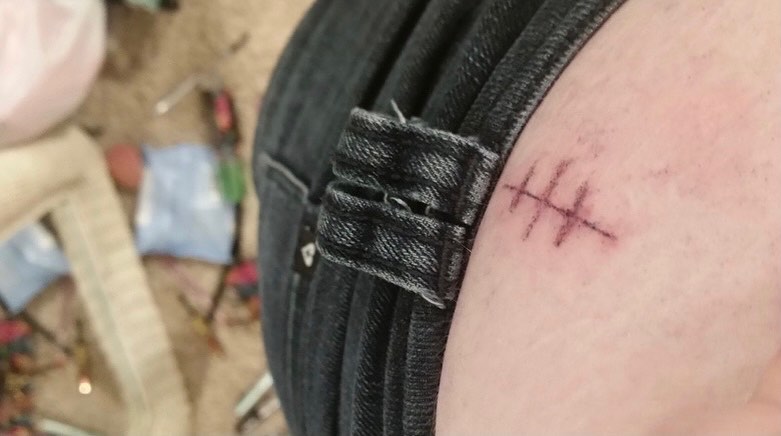
Scars could be caused by damage to your body before or after the tattoo, however for this article, we’re focusing on the 4 aspects of getting a tattoo (and healing) that can cause a scar.
If you’re thinking of getting your first tattoo, it’s important that you are aware of these problems and know how to avoid them!
1. Heavy Handed Tattoo Artist
As mentioned above, your body will try to form scars if damage is made to the dermis layer and below. So, your tattoo artist should be delicate and know how to only dip the needle a millimeter into your skin to deposit the ink.
Tattoo guns, as they are sometimes called, press the needle into your skin up to 200 times per minute. Importantly, the level of pain you experience while getting a tattoo isn’t related to scarring. Instead, it’s more to do with the body area (bony, thin-skinned areas hurt more) and pain tolerance.
If the tattoo artist dips too deep with the tattoo needle, then your body could form scars as it heals. Unlike scars that are due to a problem with the healing process, these types of scars are very difficult to see.
You may only realize you have a tattoo scar when the tattoo is fully healed several weeks later. It will be a raised or bumpy area (or line) of the tattoo. It may also be a faded or white color.
Also Read: How Deep Should a Tattoo Needle Go?
2. Predisposition to Scarring
According to a review study looking at genetic susceptibility to raised dermal scarring, “there is compelling evidence for a genetic component to these conditions, given the familial predisposition, varied incidence in different ethnic populations and the presence in twins.”
What exactly does this mean?
Well, you could be more prone to developing scars due to your genes. While one person might heal from a tattoo without scars, someone else will develop scars even if the tattoo is the same in every way.
If you are genetically susceptible to scarring, you may already have scars on your body. Some types of scars, like keloid scars, can develop from even the smallest wound like a tiny minimalist tattoo or even an ingrown hair.
If you’re concerned about scars or think that you may be genetically predisposed to scarring, then definitely talk to your doctor. They may be able to treat your existing scars and give you advice for minimizing scars in the future.
3. Tattoo Peeling/Scabs
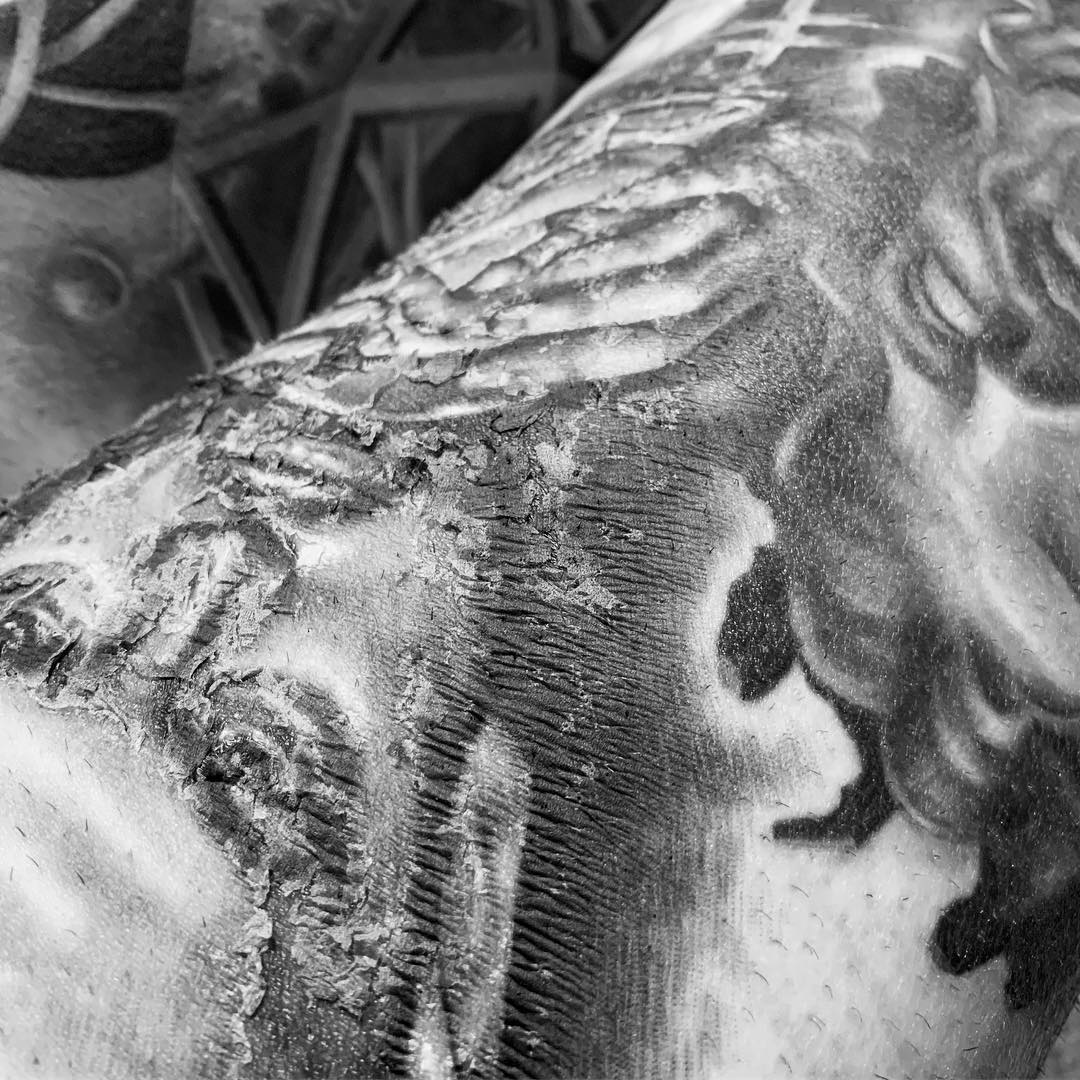
Tattoo peeling is a completely normal process. In fact, it would be unusual to heal from a tattoo without scabs and peeling skin! But while this part of the healing process is totally normal, you can still go wrong.
- The right way to practice aftercare – gently apply lotion and pat it in, allow the skin to naturally flake off, let scabs fall off when they are ready.
- The wrong way to practice aftercare – let the skin dry out by not applying lotion, pulling off skin before it falls off naturally, and picking at scabs.
If you pick at scabs and rip off skin that’s not ready to fall off, there will be consequences. You might find that you cause an infection (see below) or that you dislodge tattoo ink and ruin your body art. The other consequence that may occur is a scar.
Don’t interfere with your body during the healing stage. It may itch and it may be uncomfortable, but don’t pick at it! This is also why many people advise against wearing tight chaffing clothes on the tattooed area, as this can rub away the skin before it’s ready to flake off.
Read More: Tattoo Peeling: Is It Normal and How to Fix (Everything You Need to Know)
4. Infection
The last cause of a tattoo scar is an infection. Now, the main cause of an infection is when dirt or bacteria get onto the tattoo – this is often caused by people not taking the necessary aftercare steps. However, it’s also possible that the infection came from the tattoo parlor or is just your body’s reaction.
So, if you know someone who had a tattoo infection, don’t automatically assume that they’ve skipped aftercare or are just living in a dirty environment!
Anyway, with that point out of the way, here are the signs of an infection:
- Red swelling that gets progressively worse (some redness and swelling is normal, but it should only get better),
- Excessive oozing, pus, and a bad odor,
- Swollen blister-like lumps,
- Fever symptoms in general.
If you experience any of these problems, then don’t touch your tattoo. Picking and prodding the tattoo to “burst” or relieve pressure is going to make everything worse.
The best thing to do is go to a doctor and get treatment – they’ll likely prescribe antibiotics. To minimize the chances of scarring, keep the area clean but otherwise untouched. You may scar regardless so trying to avoid infection is so important!
Read More: Tattoo Infection: Everything You Need To Know
Overworked Tattoo Scar
An overworked tattoo scar occurs when the tattoo artist has “overworked” the skin. This is usually where the tattoo artist deposits ink into the wrong layer (above or beneath the dermis layer) or goes over a single area multiple times, thus damaging the skin more than necessary.
This is more common with an unprofessional or inexperienced tattoo artist. So, if someone offers you a free tattoo so they can “practice”, you should think carefully before accepting.
An overworked tattoo will become obvious during the healing stage. You may notice:
- Blowout – this is when the tattoo looks cloudy, distorted, or smudged because the ink hasn’t been deposited in the dermis layer. It can be hard to tell at first, but once the peeling stage comes to an end it should be obvious.
- Oozing – some oozing is to be expected in the first couple of days, however if the oozing continues into the first week and you notice blood, gunk, and ink coming from your tattoo, this can be a sign that it’s overworked. It could also be a sign of infection, so check for other infection symptoms too (find the list above).
- Texture changes – you may notice as you gently clean your tattoo that there are dips in your skin or raised areas that weren’t there before. This is another sign of an overworked tattoo scar forming.
It’s important to note that oozing and raised lines are common in the first day (or even 3 days if you’re slow to heal) but should not last. So long as your tattoo is getting better – even if it’s slow progress – then you’re on the right path.
If things get worse rather than better, you’ve got a problem and are more likely to get a scar.
Tattoo Scarring Pictures
It goes without saying that most people don’t want to take a photo when a tattoo goes wrong – they’re more likely to cover it up and hope that no one asks about it!
If you do have a tattoo scar, there are some options. Read about these in the next section of our guide. But for now, let’s look at some infected tattoos to analyze what exactly has gone wrong and whether scarring is likely or not.
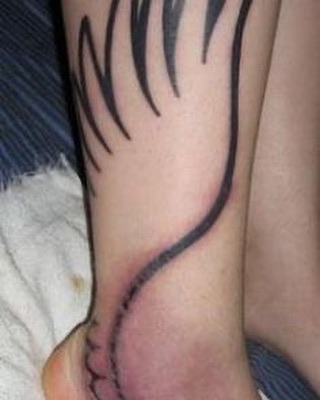
Starting with this blurry image, we can see the signs of either an overworked tattoo or the early stages of an infection. The tattoo line itself looks to be scabbed over or in the peeling stage, while the area around it is swollen and red in general.
This is a non-oozy wound, which may indicate that the swelling is just the body’s reaction to the tattoo. It could also be a sign of an overworked tattoo where the area has been repeatedly jabbed with the needle one too many times.
If the ink was deposited in the wrong layer, you might also see some oozing of excess ink and blood.
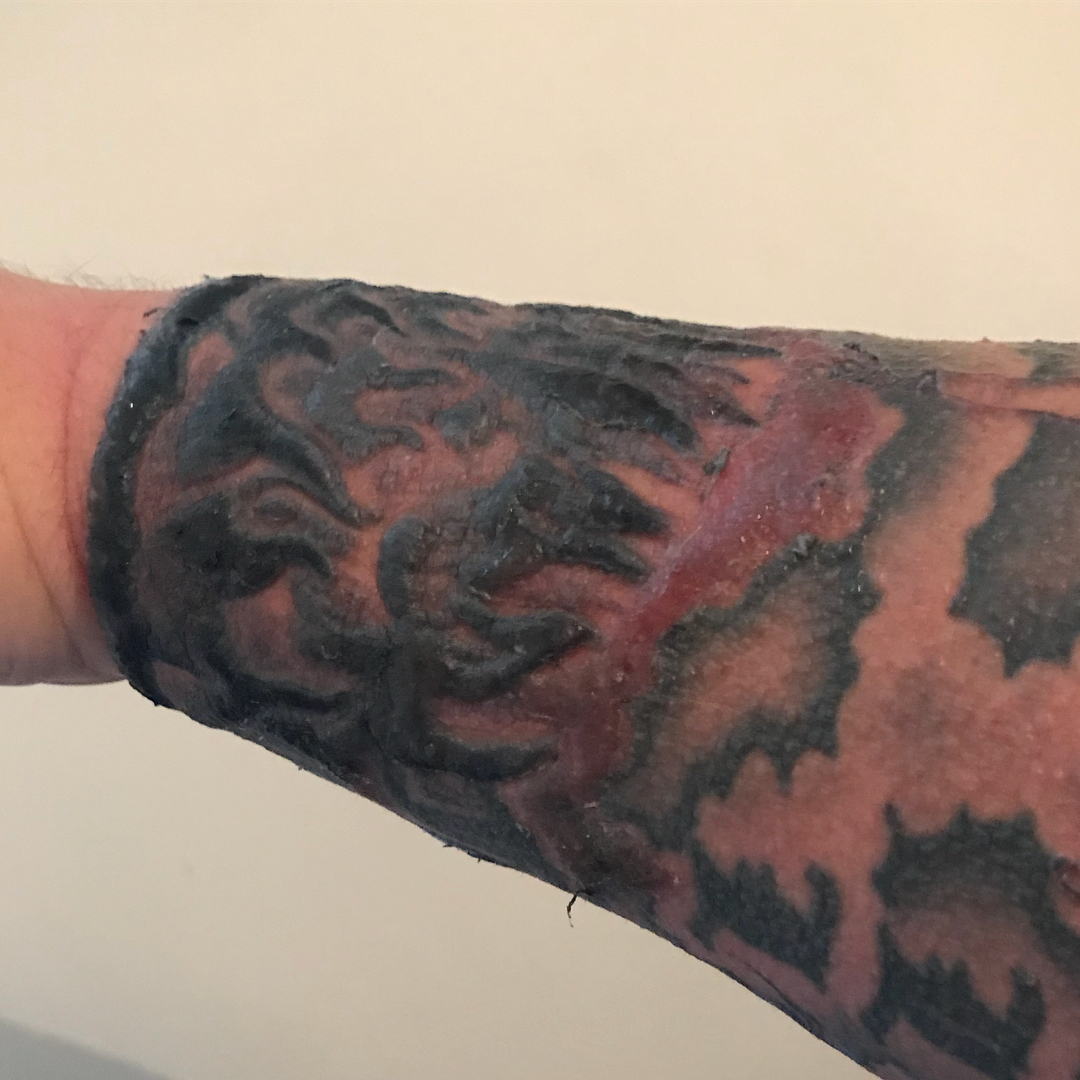
Speaking of blood and ooze, this photo shows either an infection or a reaction to the lotion used during aftercare – either could result in scarring. The owner of this tattoo states that they’re feeling down and have been to see the doctor who put them on antibiotics and steroids to reduce the swelling and kill the infection.
There’s an important lesson here – don’t just apply any old lotion to your healing tattoo. Stick with either the product that your tattoo artist recommends, or a lotion/balm that’s especially designed for healing tattoos.
Your product shouldn’t contain any ingredients that will inflame the tattoo further. With an infection like this, you increase your chances of developing a tattoo scar.
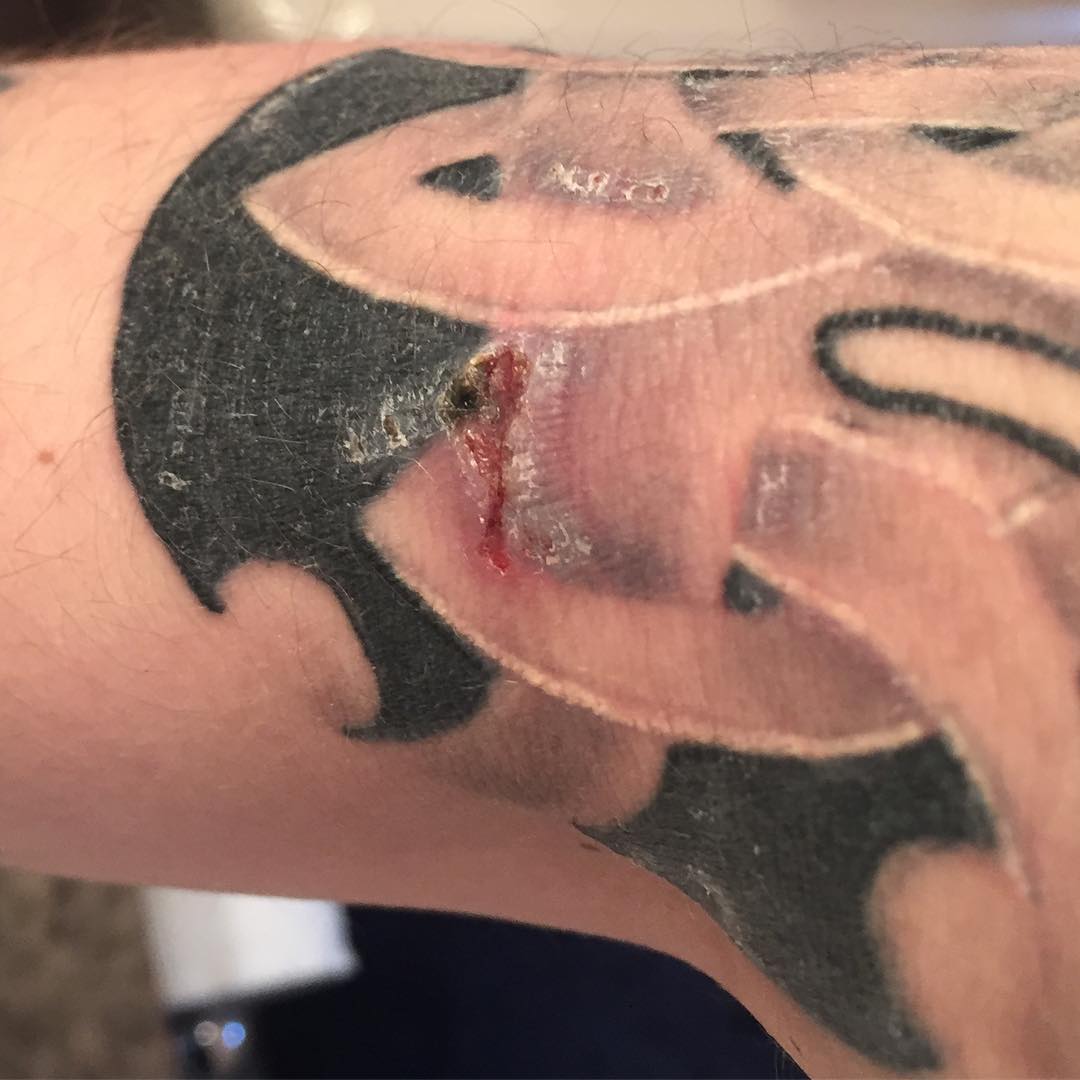
This picture shows a less oozy tattoo wound. It’s a classic sign of either an infection, or a scab that has been picked off before it was ready to fall off naturally. You can also see that the skin looks a little dry in general.
Dry skin becomes brittle and won’t naturally flake off without causing damage. That’s why applying the right product is important.
Of course, try not to make your skin moist. Pat a paper towel on your tattoo after applying lotion to remove any excess liquid that would otherwise become a happy home for festering infections.
Luckily for this person, the infected area is quite small and hasn’t spread to other areas of the tattoo, which means that if there is a scar, it will be simpler to fix.
How to Get Rid of Tattoo Scarring
The two best options are to cover up the scar, either by getting a tattoo directly on the scar tissue or opting for surgery to remove the scar completely. Scar removal surgery, also called scar revision, is a type of plastic surgery (often meaning it’s performed for aesthetics more than anything else).
Tattoo Scarring Cover Up
If your tattoo scar is very prominent and ruins the entire aesthetic of the tattoo, then you might need to cover it up with another tattoo entirely.
This may be the case if you have keloid scarring that has expanded drastically.
Tattoo Scarring Touch Up
If your tattoo scar is minimal, like just a 1cm scar where the tattoo artist overworked a line, then a simple touch-up session will suffice. The tattoo artist may just go over the scar tissue once it has healed to fill the gap.
Besides these two options, there’s not much you can do about scars after they have formed. Preventative measures are preferred!
Tattoo Removal Scarring: A Different Problem!
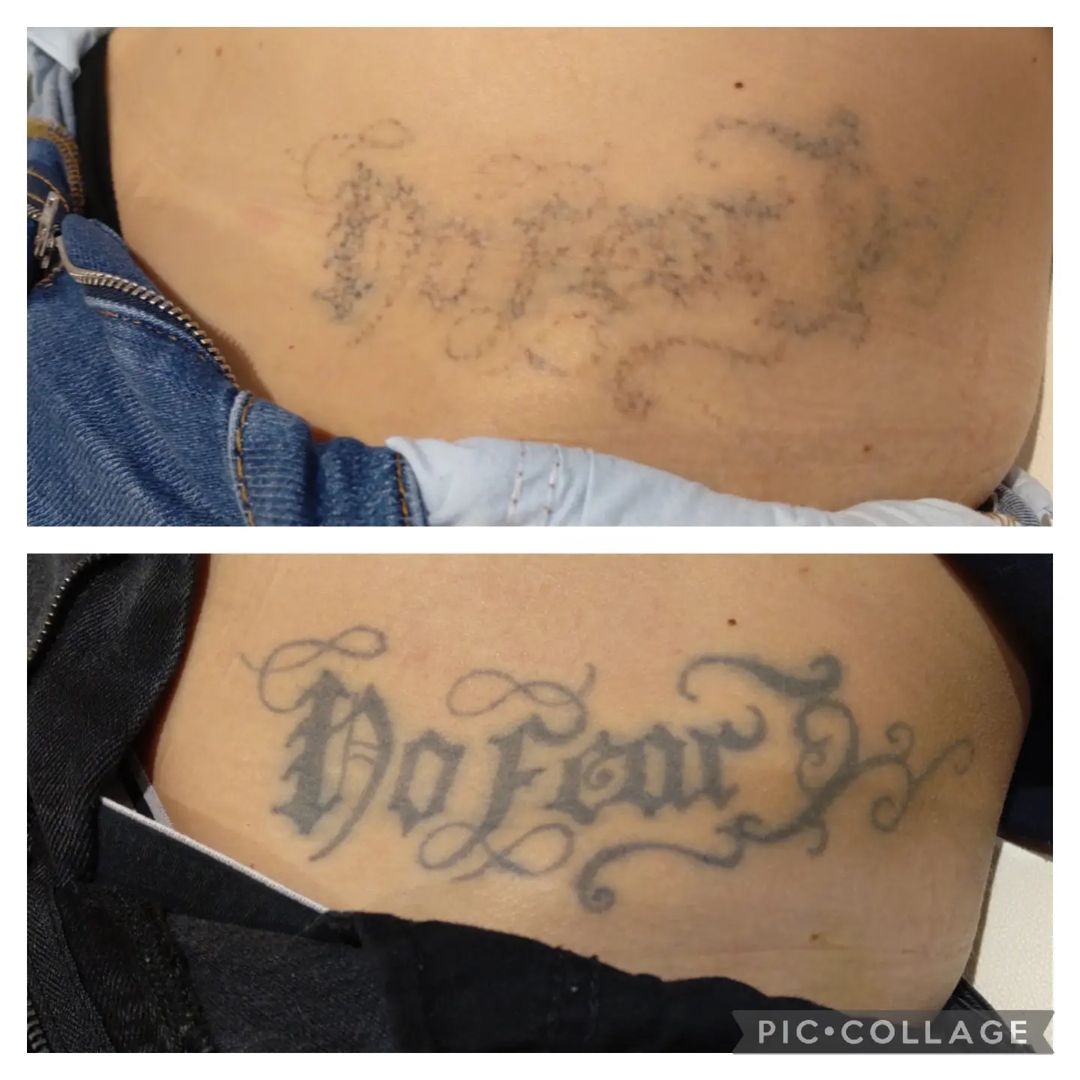
If you have a tattoo but you want it gone, then you may be considering tattoo removal. But this can also cause scars!
One important note: professionally operated modern lasers do not cause scarring no matter what people tell you. Some very old models used to cause scarring, but that was decades ago. So don’t worry.
Tattoo removal can cause scarring if you use a dangerous method. For example, trying to sand off the tattoo with an abrasive or acidic material is likely to cause a scar. Furthermore, some cream and balm products may appear to be authentic (and are even sold on Amazon) but do not work. At all.
Professional tattoo removal with a laser is expensive and takes several sessions, however the results are impressive and once it is finished you won’t be able to see the tattoo at all. It’s important that you get professional treatment as DIY tattoo removal ends in horror stories.
Don’t just take our word for it. Reddit users have had some terrible tattoo removal experiences too.
DIY tattoo removal from TattooRemoval
Tattoo Over Scarring
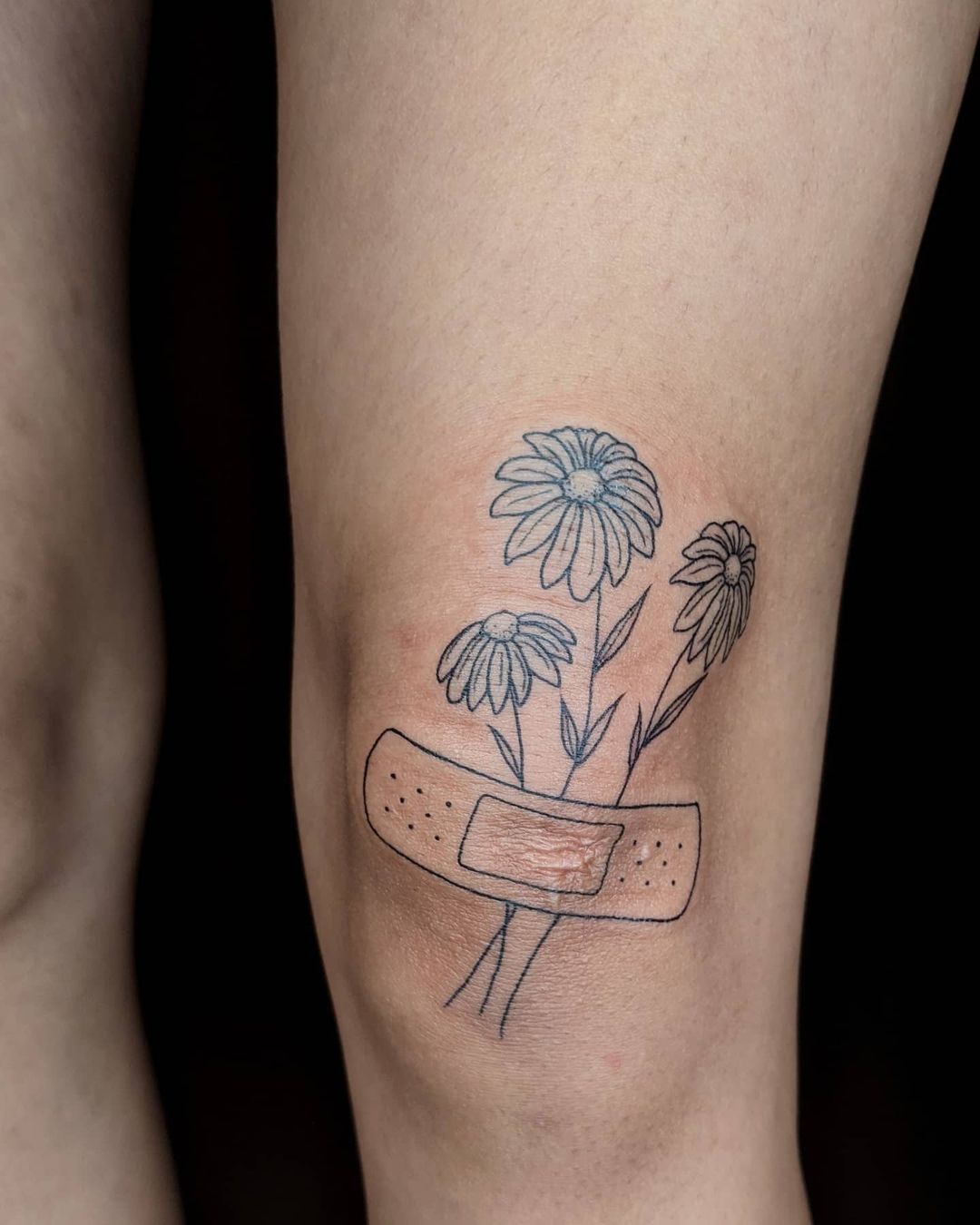
If you have a scar already, then you might want to get a tattoo over the scar or around the scar to cover it up… or highlight it!
This is a lovely idea and can be very meaningful, especially if the scar is from a medical procedure that you survived. Not all tattoo artists will be practiced in tattooing over scars, so you may need to find a new parlor that can handle this request.
You should also keep in mind that tattooing directly on scar tissue is considered more painful that tattoos on uninjured skin.
One final thing to note is that if you are susceptible to keloid scars or have a genetic predisposition to scarring, then getting a tattoo over a scar could just make things worse.
But in general, getting a tattoo on or over a scar is completely doable and quite a popular practice.
FAQs
Does tattoo scarring go away?
Scars can fade over time, but they don’t just go away. If the tattooing process has left you with a scar, your options are to get the scar surgically removed or tattoo over the scar tissue.
What causes tattoo scarring?
Your body creates scars when the skin has been traumatically injured, so it produces scar tissue to mend. Usually, the tattoo process embeds ink in the dermis layer, which doesn’t result in scarring. Factors that can cause tattoo scarring include: an amateur tattoo artist who embeds ink at the wrong depth, an infection or damage to the tattoo during the healing process, or a genetic predisposition to scarring.
Is tattoo scarring normal?
No, it’s not normal and it’s not what people aim for. When you get a tattoo, you want the area to be smooth and scar-free, so you can see the artwork clearly. Scars occur when your body tries to heal more serious damage, like an infection.
Sometimes scarring is unavoidable, even if you take care of your tattoo carefully. That’s why you should take some time to find a professional and experienced tattoo artist.
Is my tattoo scarring or healing?
If your tattoo is healing, it should start off red and raised, but slowly reduce. Scabs and peeling is normal and doesn’t indicate a scar.
However, if the tattoo gets worse rather than better, or it is oozing and swollen red for longer than a few days, this can be a sign of an infection that could lead to a tattoo scar.
What are tattoo keloid scars?
Keloid scarring is a thick, raised scar that forms after your skin has been injured and healed – sometimes years and years after. They look like blotchy, rubbery, red raised patches that can sometimes be itchy or uncomfortable.
Most scars stay on the area that’s affected – in this case, the area that has been tattooed. However, keloid scars can grow and expand, so it’s important to seek treatment. If you suspect you have a keloid scar forming, talk to your doctor.
If you have a keloid scar and want to seek treatment for it, then book an appointment with a dermatologist.
What are tattoo hypertrophic scars?
Hypertrophic scars are very thick, raised, and visible scars that can occur when your wound heals, so it’s possible to get hypertrophic scars after a tattoo if the healing process doesn’t quite go to plan. Technically, you could get them tattooed to lighten the color and make them less visible, but a better treatment plan is to soften and flatten the scars instead.
Laser therapy, cryotherapy, and surgery are some of the options open to you. Whichever way you want to remove your scars, you’ll need to talk to a doctor.
[ad_2]
